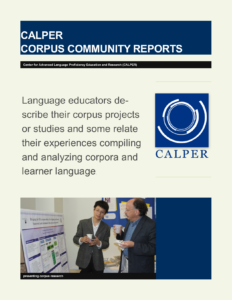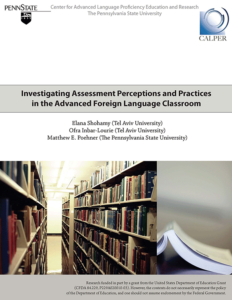Corpus Community Reports
CALPER’s Corpus Community Reports consist of a set of documents where language educators describe their corpus projects or their studies and some relate their experiences compiling and analyzing copora and learner language. The Corpus Community Reports are intended to provide those interested in working with copora with first hand insights into projects of language teachers and researchers.
For more information on the use of corpora Go to our Corpus Portal Website

Publication Units:
No. 1 Working with a Spoken Burmese Corpus by San San Hnin Tun (Cornell University), 2007 [PDF]
No. 2 Discourse Markers in Turkish and English: A comparative study by Nurdan Gürbüz (Middle East Technical University, Turkey), 2008 [PDF]
No. 3 Thai Pop Music: A specialized corpus for the language classroom by Teddy Bofman and Paul Prez (Northern Illinois University), 2009 [PDF]
No. 4 Using a Corpus Effectively in a Spanish Grammar Course by Carlos Benavides (University of Massachusetts, Dartmouth), 2013 [PDF]
No. 5 Using Parallel Corpora in Teaching Chinese as a Foreign Language by Brody Bluemel (The Pennsylvania State University), 2013 [PDF]
Investigating Assessment Perceptions and Practices in the Advanced Foreign Language Classroom
This paper reports on the research results of a survey conducted in 2005-06 to examine issues relating to advanced language proficiency (ALP) and its assessment in classroom settings. Specifically, it focuses on the views of language teachers of varied backgrounds (in Foreign Languages, and English as a Second Language, at both high schools and universities) on assessment of ALP, and on these teachers’ actual assessment practices.
The report is divided into three components: 1) survey of current thinking about ALP and its assessment in classroom instruction; 2) results of survey that assessed testing perceptions and practices of ALP; 3) conclusions from the theory and research reviewed and recommendations for the direction of future research and practices relating to the assessment of ALP.

Language Learning in Study Abroad: Case Histories of Americans in France (2008)
Study abroad (SA) has long been understood as a major source of foreign language competence for American students. Based on a large-scale, national assessment project, Carroll (1967) named time spent abroad as one of the most potent variables predicting language proficiency. Based on this solid proof claim, researchers have since investigated language learning in SA using diverse methods and adopting a wide variety of theoretical approaches (e.g., DuFon & Churchill, 2006; Freed, 1995). Over time, concern with general proficiency has given way to studies in which particular aspects of language competence (e.g., fluency, vocabulary growth, pragmatics) are scrutinized in separate studies. The results of these investigations generally show that while SA is certainly a productive context for language learning, its outcomes are neither as dramatic nor as equally distributed among students as one might hope they would be.

Language Learning in Study Abroad: Case Histories of Americans in France (2009)
Published as: The Modern Language Journal, Volume 92, Monograph, 2008
Study abroad (SA) has long been understood as a major source of foreign language competence for American students. Based on a large-scale, national assessment project, Carroll (1967) named time spent abroad as one of the most potent variables predicting language proficiency. Based on this solid proof claim, researchers have since investigated language learning in SA using diverse methods and adopting a wide variety of theoretical approaches (e.g., DuFon & Churchill, 2006; Freed, 1995).

Language Learning in Study Abroad: Case Histories of Americans in France (2009)
Published as: The Modern Language Journal, Volume 92, Monograph, 2008
Study abroad (SA) has long been understood as a major source of foreign language competence for American students. Based on a large-scale, national assessment project, Carroll (1967) named time spent abroad as one of the most potent variables predicting language proficiency. Based on this solid proof claim, researchers have since investigated language learning in SA using diverse methods and adopting a wide variety of theoretical approaches (e.g., DuFon & Churchill, 2006; Freed, 1995).
